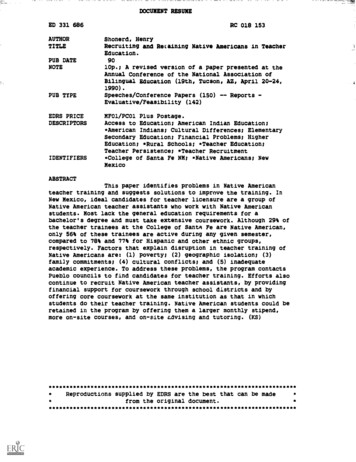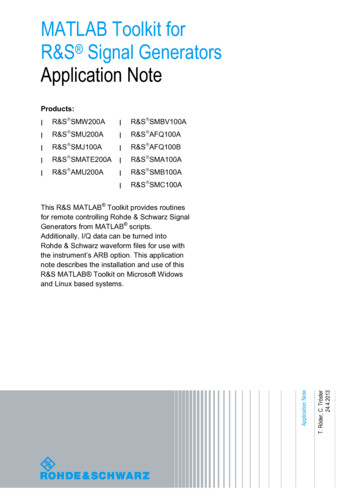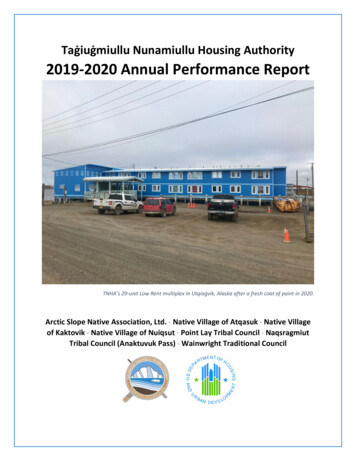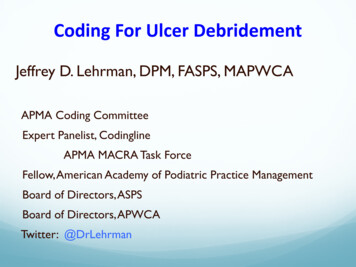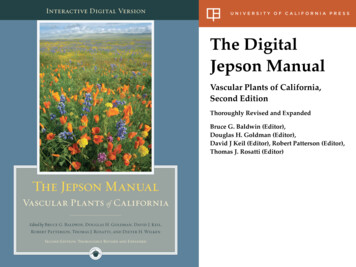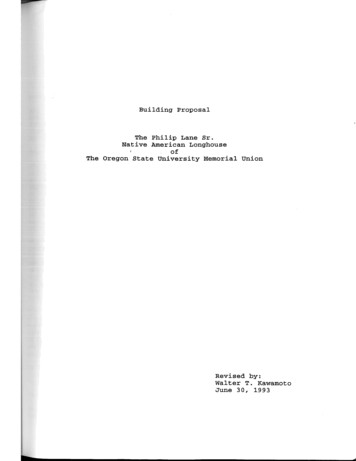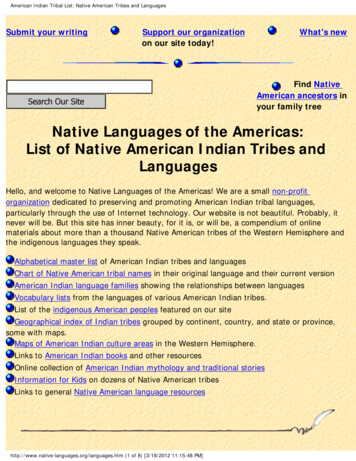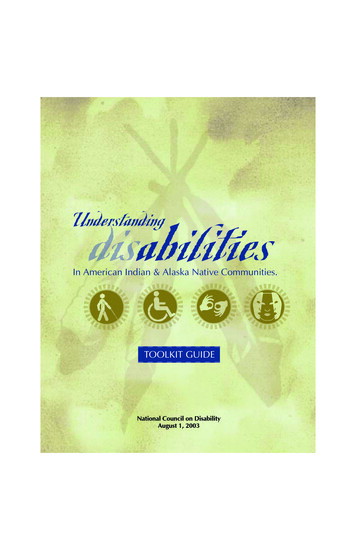
Transcription
UnderstandingIn American Indian & Alaska Native Communities.TOOLKIT GUIDENational Council on DisabilityAugust 1, 2003
National Council on Disability1331 F Street, NW, Suite 850Washington, DC 20004Understanding Disabilities in American Indian and Alaska NativeCommunities: Toolkit GuideThis report is also available in alternative formats and on NCD’s award-winning Website at www.ncd.gov.Publication date: August 1, 2003202-272-2004 Voice202-272-2074 TTY202-272-2022 FaxThe views contained in this report do not necessarily represent those of theAdministration as this and all NCD reports are not subject to the A-19 ExecutiveBranch review process.
About the CoverThe four symbols on the cover of the Toolkit Guide were chosen to represent thespectrum of disabilities, whether visible or hidden, that may be experienced byindividuals in the American Indian and Alaska Native community. The universal mean ing of each symbol is described in the captions below along with the meaning of thesymbol as it is used in this Toolkit specifically.Access for People Who Are Blind or Have Low Vision (blind with cane)Universally, this symbol identifies areas that are specifically designed tobe accessible to or in some cases tailored to the unique abilities ofindividuals who are blind or have low vision. Within the Toolkit, thissymbol is used to represent the community of individuals for whom sightis not a primary sensor y tool.Mobility Access Symbol (wheelchair)The wheelchair symbol indicates access for individuals who have amobility disability, including individuals who use wheelchairs. Thesymbol is most commonly used to indicate an accessible entrance,bathroom, or environment that is sensitive to individuals with specificmobility access needs. Within the Toolkit, this symbol is simply used torepresent the community of individuals with mobility needs of this kind.Communication Access for People Who Are Deaf or Hard of Hearing(signing hands)This symbol typically indicates that sign language interpretation isprovided for a lecture, tour, per formance, conference, or other program.Within the Toolkit, the symbol is used to represent the community ofindividuals whose primar y means of communication is sign language.Hidden Disabilities (face beneath face)This symbol was designed specifically for the Toolkit after the TechnicalExpert Panel determined that there were currently only universalsymbols for disabilities that are seen, leaving out the experiences ofindividuals with epilepsy, developmental disabilities, alcoholism, mentalillness, learning difficulties, diabetes, and others who are notrepresented by the universal disability symbols. The symbol was inspiredby the art of many indigenous cultures that designed faces with multipleoverlaid masks. This symbol represents the community of individualswho have disabilities that are not externally visible but significantlyimpact an individual’s life.i
AcknowledgmentsThe National Council on Disability’s (NCD) Understanding Disabilities in AmericanIndian and Alaska Native Communities: Toolkit Guide was developed through thepassionate collaboration of many individuals. The foundation of this project wasformed in a powerful sharing of experiences, knowledge, and hopes amongconsumers and advocates who live with disabilities. These individuals strived tocreate a new perspective about what it means to be an American Indian or an AlaskaNative with a disability. This new consciousness will ser ve to transform Indiancommunities nationally and offer a new hope to so many individuals who for so longhave felt invisible with no voice.NCD expresses its gratitude to the team at Kauffman and Associates, Inc., fordrafting this toolkit. Team members include Project Director Dr. Martina Whelshula,Victor Paternoster, Tim Spellman, Wendy Thompson, and Ara Walline.Others who have greatly supported the development of this work and deserve specialacknowledgment are Mike Blatchford, consultant; Kathy Langwell and Project HOPE;Desautel Hege Communications; Robert Shuckahosee, consultant; Frank Ryan,consultant; the Consortia of Administrators for Native American Rehabilitation(CANAR); the American Indian Disability Technical Assistance Center; the AmericanIndian Rehabilitation Research Training Center; the National Congress of AmericanIndians (NCAI); focus group participants at NCAI and CANAR conferences; and JudyBabbit from the City of San Antonio Disability Access Office.A special acknowledgment goes to those who represent the heart and soul of thiseffort, our Technical Expert Panel members: Mark Azure, Julie Anna Clay, Julia DavisWheeler, LaDonna Fowler, Joanne Francis, Joseph Garcia, Cordia LaFontaine, CarolLocust, Danny Lucero, David Miles, Damara Paris, Andrea Siow, H. Sally Smith, RahoWilliams, Alvin Windy Boy. Thanks also to Jessie Stewart, age 10, for sharing her stor y.In attempts to understand the complex make-up of Indian country as it addresses theneeds of tribal members and descendants with disabilities, tribal program directorsshared willingly about the challenges and inspirations experienced in their work. NCDii
acknowledges these individuals and the tribes they represent: Jo White, OglalaNation at Pine Ridge; Arlene Templer, Confederated Salish and Kootenai Tribes; RitaLaFrance, St. Regis Mohawk; Rhonda Talaswaima, Hopi Nation; Darlene Finley, ThreeAffiliated Tribes; Linda Pratt, Yakama Nation; Larry Alflen, Pueblo of the Zuni; Steven“Corky” West, Oneida Nation; Ella Yazzie-King and Paula Seanez, Navajo Nation; andLen Whitebear, Cook Inlet Tribal Council.iii
Technical Expert PanelSeveral individuals representing consumers and advocates within the AmericanIndian and Alaska Native disability community nationwide were recommended toserve as members of a national Technical Expert Panel. The Technical Expert Panelserved as project consultants and advisors providing guidance to the staff on thedirection of the project. The Panel was instrumental in providing critical feedback anddirection on the multitude of issues addressed throughout the development of thistoolkit. The Technical Expert Panel members are as follows:LaDonna FowlerTurtle Mountain Chippewa/SanteeSioux/AssiniboineMark AzureTsimshian/Hunkpapa LakotaIntertribal Deaf CouncilChairperson, Subcommittee on Disabil ity, National Congress of AmericanIndiansConsumerJulie Anna ClayOmaha TribeCo-Founder, American Indian Rehabili tation Rights Organization of War riors (AIRROW)Training and Dissemination CoordinatorAmerican Indian Rehabilitation Research and Training Center (AIRRTC)National Board Member, AIRRTCSecretary, Multicultural Committee,National Council on IndependentLivingConsumerJulia Davis-WheelerCo-Secretary, Native American Alliancefor Independent LivingNez PerceNez Perce Tribal CouncilCharter Member, Cultural DiversityAdvisory Committee for NationalCouncil on DisabilityChair, National Indian Health BoardNative American Disability Consultant/Consumeriv
Joanne FrancisAkwesasne MohawkDavid MilesNez Perce TribeInternational Disability ConsultantDirector, Nez Perce Vocational Rehabilita tion ServicesFounding Member, AIRROWConsumerBoard Member for the Idaho State Inde pendent Living CouncilJoseph Garcia Prairie Band of Potawatomi Board Member for the Idaho State Reha bilitation CouncilBoard Member – American IndianDisability Technical Assistance CenterStudent, Salish Kootenai CollegeConsumerCordia LaFontaineConsumerCarol Locust Eastern Band Cherokee Indian Health Services Health ConsultantCultural Sensitivity Trainer & ConsultantConsumerDanny LuceroNavajo/Apache NationsVice President, Intertribal Deaf CouncilGallaudet UniversityConsumerDamara ParisCherokeePresident, Intertribal Deaf CouncilConsumerAndrea SiowHopi NationConsumerH. Sally SmithTribal LeaderAlaska Native Health BoardNational Indian Health BoardRaho WilliamsNavajo NationIndependent Living SpecialistSan Juan Center for IndependenceConsumerAlvin Windy BoyChippewa-CreeTribal LeaderRocky Boy Reser vationv
Toolkit Table of ContentsGetting StartedWelcome to the ToolkitHow many Indians live on tribal lands?Did you know at least 555,000 Indians live with disabilities?What is a disability?What disabilities do we find in Indian communities?12234Barriers and ChallengesReferences58Healthy LivingBackgroundHealth CareIndian Health Ser viceMedicaidMedicaid Home- and Community-Based Ser vices (HCBS)MedicareState Children’s Health Insurance Program (SCHIP)Sports and cationBackgroundFederal Special Education LawIndividualized Education ProgramsTips for Parents at IEP Meetings27282829vi
IEP ChecklistProblem SolvingOffice of Special Education ProgramsStrategic Direction 1Strategic Direction 2Strategic Direction 3Strategic Direction 4Strategic Direction 5OSEP-Sponsored ResourcesIDEA Par tnershipsTechnical Assistance Alliance for Parent CentersTechnical Assistance and Dissemination 424346Independent LivingBackgroundModel ApproachesASSIST! to IndependenceNative American Independent Living Ser vices (NAILS)Native American Advocacy Project (NAAP)ResourcesFederal Funding for Independent Living CentersStatewide Independent Living CouncilsLocal Independent Living CentersIndependent Living AdvocacyReferences4951525354565657575860Vocational Rehabilitation and Employment ResourcesBackgroundVR Ser vice and Employment Basics for the ConsumerQualifying for Vocational Rehabilitation ServicesTicket to WorkEmployment ProtectionsHow to File Complaints636464656566Consumer Disability Resources68vii
Mental HealthAlcohol and Substance AbuseSpinal Cord InjuryTraumatic Brain InjuryTribal VR Program ResourcesReferences697071737581Assistive TechnologyBackgroundModel ApproachesASSIST! to Independence838386Native American Advocacy Project (NAAP)ResourcesState Assistive Technology Financial Loan Programs andOther Loan Programs Ser ving Native AmericansGeneral Assistive Technology Resources Available to Native AmericansAssistive Technology AdvocacyReferences878889898991Housing and FacilitiesBackgroundThe Basics of Universal DesignAssessing Service NeedsModel ApproachesMaking Plans a RealityWhom do I contact first for help in making my home or workplace accessible?What legislation impacts housing for tribal members with disabilitiesand how do I file a complaint if the laws are not being honored?Where do I learn more about universal design?Whom can I contact for technical assistance, training needs, networkingopportunities, and research information on housing?What types of funding are available for tribal housing programs lookingto create accessible facilities for tribal members, and how do I apply?Referencesviii9394969799100100102103107109
TransportationBackgroundAssessing Service NeedsDefinitionsModel ApproachesPueblo of the ZuniConfederated Salish and Kootenai TribesOther ProgramsMaking Plans a RealityHow do you find out about transportation ser vices in your area?What do you do if there are no transportation services in your area?How do you assess the transportation needs and develop a ser vicenetwork in your community?How do you find funding to support transportation servicesand programs?Who provides assistance with compliance?What legislation on the horizon could impact transportation servicefunding? How do you keep informed about the impact of pendinglegislation on transportation in tribal 20120124128129131Key Elements of Promising ProgramsBackgroundLeadershipLeadership CharacteristicsConclusion133134135137Advocating ChangeSelf-AdvocacyGiving Voice to Your Life ChoicesSpeaking Up About Ser vicesStep 1: TargetingStep 2: PreparingStep 3: InfluencingStep 4: Following Through139140141142143143143ix
Guidelines for Writing a ResolutionPurpose of Submitting a ResolutionResolution FormatSample ResolutionsReferences144145145146156Federal Disability Laws and TribesBackgroundUnderstanding Government-to-Government RelationshipsThe Americans with Disabilities Act (ADA) and TribesThe Rehabilitation Act and TribesThe Individuals with Disabilities Education Act and nal Initiatives, Federal Agencies, and National OrganizationsBackgroundInitiativesFederal Disability AgenciesNational Disability OrganizationsReferences163163164170182Disability Etiquette HandbookDos and Don’tsConversation EtiquetteGlossar y of Acceptable TermsPreparing for Sign Language InterpretersResources Regarding InterpretersSer vice AnimalsWhat Is a Ser vice Animal?Ser vice Animal AccessSer vice Animal EtiquetteSer vice Animal 94x
GETTING STARTEDGetting Started
GETTING STARTEDMark AzureAs a child when I moved to a deafschool off tribal lands I couldn'tparticipate in my cultural rituals suchas powwows and ceremonies. My lifewas like a torn piece of paper.When I could reconnect theseceremonies and my ability to be firsta Native American and then a deafperson, my life came together again.This is what I want—to help rebuild ourculture so everyone can do this.
Welcome to the ToolkitA powerful voice in Indian countr y has emerged, strongly pronouncing that AmericanIndian people with disabilities do not need to be “cured” or “fixed.” In truth, equalaccess, fair accommodations, and an opportunity to make power ful contributions toour society are needed.“Treat all men alike.Give them all the same law.Give them all an even chance tolive and grow. All men were madeby the same Great Spirit Chief.They are all brothers. The Earth isthe mother of all people, and allpeople should have equal rightsupon it. Let me be a free man,free to travel, free to stop, free towork, free to trade free to thinkand talk and act for myself.”By eliminating the barriers, AmericanIndian and Alaska Native (AI/AN) peoplewith disabilities can work together inpartnership to make tribal communitiesmore accessible, more caring, and morerepresentative of the beautiful, uniquecontributions each individual brings to thisworld.Indian people with disabilities and tribalChief Joseph, Nez Perceleaders who ser ved together on aTechnical Expert Panel for the NationalCouncil on Disability (NCD) designed this Toolkit. They hope that the information,encouragement, and resources found in this Toolkit will help you and your communitycreate the awareness, support, encouragement, and empowerment to improve thelives of people with disabilities and their families.In this Toolkit, you will find information about disabilities, Indian tribes, andresources. You will also find suggestions for improving services, providingprotections, and tapping resources in local tribal communities for people withdisabilities. This guide will focus primarily on health care, independent living,education, and vocational rehabilitation. In addition, resources are provided in theareas of housing and transportation.1
Each section of the Toolkit will provide specific contact information by topic fororganizations that may be of further assistance to you. Where possible, the narrativedescribing each organization’s mission and role has been directly quoted from theorganization’s Web site, and the Web site address has been identified in order toprovide the most accurate and useful information.AI/AN people with disabilities, especially those who live in Indian countr y, faceunique circumstances and legal environments that require special outreach,consultation, protections, and services. There is a great desire among AI/AN peoplewith disabilities to work in partnership with sovereign tribal governments to maketribal communities and work places accessible and welcoming to people withdisabilities.How many Indians live on tribal lands?According to the 2000 U.S. Census, nearly 2.5 million Americans identify themselvesexclusively as “American Indian or Alaska Native.” There are 4.1 million people whoidentify themselves either as Indian only or Indian in combination with another race(Ogunwole, 2002). Of this total, approximately 944,433 Indian or Alaska Nativepeople live on federal reservations or on off-reservation trust lands (Langwell andSutton, 2002). Of the 50 states, 35 have federal reservations within or overlappingstate borders.The Federal Government, through the Bureau of Indian Affairs (BIA), officiallyrecognizes 560 tribes and Alaska Native villages (Ogunwole, 2002). They are knownas “Federally Recognized Tribes.”Did you know at least 550,000 Indians live with disabilities?Data from the 1997 Survey of Income and Program Participation found that 22percent of the American Indian and Alaska Native population has one or moredisabilities (McNeil, 2001). This is the highest rate of disability when compared withall other races in the United States. The rate of disability varies significantly by race:2
RaceU.S. all racesWhiteBlackHispanicAsianPercentage with Disabilities20%20%20%15%10%American Indian22%If we consider only the 2.5 million who reported on the 2000 census that theyidentify themselves exclusively as “American Indian or Alaska Native,” this meansthat at least 550,000 Indians and Alaska Natives have disabilities.What is a disability?The Americans with Disabilities Act (ADA)defines a disability as follows:The term “disability” means, with respectto an individual – (A) a physical or mentalimpairment that substantially limits one ormore of the major life activities of suchindividual; (B) a record of such an impair–ment; or (C) being regarded as having such“There is no uniform definitionof disability since governmentagencies define disabilitydifferently. Further cloudingthe picture, some healthdemographers do not definedisability as completely as dorehabilitation demographers.”National Center for the Disseminationof Disability Research, 1999an impairment (42 U.S.C § 12101 et seq.).Other, similar definitions are found in the Rehabilitation Act and the Social SecurityAct. You may find that eligibility for certain benefits, such as Social Security Income(SSI) for people with disabilities, may require a more rigorous definition. For example,the Social Security Act defines disability as follows:.the term ‘disability’ means (A) inability to engage in any substantialgainful activity by reason of any medically determinable physical or mentalimpairment which can be expected to result in death or has lasted or canbe expected to last for a continuous period of not less than 12 months, or(B) blindness (42 U.S.C. 416 § 216 [42 U.S.C. 416] (1)(1))3
While definitions var y, nearly all these definitions rely upon some measure offunctional limitation to determine severity. This is done using activities of dailyliving (ADL) or instrumental activities of daily living (IADL).ADL include eating, walking, using the toilet, dressing, bathing, andgetting in/out of bed.IADL include cooking, shopping, managing money, using a phone, doinglight or heavy housework, and getting out of the home.Assessing the severity of a disability is done by totaling the number of ADL or IADLexperienced by an individual (NRCNAA, 2002).What disabilities do we find in Indian communities?Every type of disability that is found in the general population can also be found inthe AI/AN population. Several small studies have surveyed tribal communities toidentify most frequent types of disabilities. These studies (Clay, 1992; RuralInstitute on Disabilities, 1995; AIDLP, 2000) generally found that the followingtypes of disabilities are most often reported in Indian community sur veys: Spinal cord injur y (see Vocational Rehabilitation [VR] section for moreinformation) Diabetes complications Blindness Mobility disability Traumatic brain injury (see VR section for more information) Deafness or hardness of hearing Orthopedic conditions Arthralgia Emotional or mental health conditions (see VR section for more information) Learning disabilities Alcoholism or drug dependence (see VR section for more information)Not all disabilities are easily seen or can be seen at all. Many individuals have4
hidden or unseen disabilities, such as emotional or mental health problems, learningdisabilities, alcohol/drug dependence, or deafness. Some people are born with theirdisability, or develop the disability early in life. Other people acquire their disabilitylater in life as a result of disease, age, or injur y.If we live long enough, we will each experience life with a disability.Barriers and ChallengesAttitude: Most nondisabled people do not understand people with disabilities. Toooften we see the disability and not the person. This is also true in our AI/ANcommunities. You can help change this!Lack of Awareness: There is a lack of understanding about the number of Indianswith disabilities, the types of disabilities in Indian communities, and the variousopportunities our tribal government and service programs have to better protect andassist people with disabilities in Indian countr y.Legal Enforcement Unclear: Federal laws designed to protect people with disabilitiesare not always enforceable against tribal governments because of the sovereignimmunity and sovereign status of tribal governments. This does not mean that allenterprises located on tribal lands are exempt from federal laws, only that tribalgovernments are unique. Many tribes have opted to adopt their own ordinances andcodes to protect Indian people with disabilities within the tribal system.Rural Transportation: Most tribal lands are located in rural and remote areas of theUnited States and lack public transportation systems, which could provide peoplewith disabilities with access to transportation and increased independence.Rural Infrastructure: Tribal communities may not have the infrastructure to supportaccess and accommodation for people with disabilities, such as sidewalks andsidewalk ramps for wheelchair access. Tribal communities may lack access to highspeed Internet or the means to acquire assistive technology for people withdisabilities.5
Public Access: Tribal and federal office buildings that serve the community are notalways accessible for people with disabilities. Some tribes may lack the resources toretrofit their buildings to accommodate people with disabilities.Complex Federal Programs: There are a variety of federal and state programs thatcan be important resources for people with disabilities on tribal lands. Theseprograms may have overlapping or conflicting responsibilities and must be navigatedwith dogged determination. Don’t take “no” for an answer.State Relationships: Relationships between tribes and states can be strainedbecause of overlapping or conflicting jurisdictions and other issues. States may offermany services and programs that can be helpful for people with disabilities and theirfamilies living in Indian countr y. It is important to remember that while tribes aresovereign governments, their members are also citizens of the state and of theUnited States and are entitled to access state programs.Education Systems: The majority of AI/AN children are educated through the publicschool systems in each state. The balance of Indian children are educated in triballyoperated schools or federal schools run by BIA. As a result, a variety of entities may havesome level of responsibility for children with disabilities in our schools (Pavel, 1995). TheIndividuals with Disabilities Education Act (IDEA) requires public schools and BIA toprovide children with disabilities with a free appropriate education based upon anIndividualized Education Program for each child. This is the law. Parents of Indianchildren with disabilities may not be aware of the services and support their children areentitled to receive and may not know how to advocate for their children effectively.Employment: Federally recognized Indian tribes are specifically exempt as employersunder Title I of ADA, which prohibits discrimination against qualified individuals withdisabilities in employment and requires that employers make reasonableaccommodation for employees with disabilities (42 U.S.C. §§ 12101 et seq.). Thisexemption is a barrier for Indians with disabilities in Indian country, particularly inrural areas where tribal governments are the largest employer. Some tribalgovernments have voluntarily complied with ADA or adopted their own codes toprotect people with disabilities from employment discrimination.6
Housing: Homes are not generally designed to meet the needs of people withdisabilities. There is limited funding at the tribal level to cover the cost of retrofittingtribal or private housing. This housing barrier can mean the difference between anindividual with disabilities living independently or living under the care of others.Every home should have some means for “visitability” for people with disabilities.Service Coordination and Advocacy: Indian people with disabilities do not alwayshave a central location where ser vices are coordinated within tribal settings. Thiscan present a major barrier, particularly for individuals with disabilities who havemultiple needs, such as housing, health care, vocational rehabilitation, andadvocacy.Personal Care Assistance: Just getting out of bed, bathed, dressed, and out of thehouse could present major barriers for some people with disabilities. Yet, with thesupport of a personal care attendant, many people with disabilities have been ableto demonstrate their value as members of the tribal workforce. Much more can bedone in Indian communities to provide home- and community-based ser vices.7
ReferencesAmerican Indian Disability Legislation Project (AIDLP) Research and Training Centeron Rural Rehabilitation Rural Institute on Disabilities. (2000). Missoula: Universityof Montana Rural Institute.Clay, Julie. (1992). A profile of independent living ser vices for American Indians withdisabilities living on reser vations. Missoula: University of Montana Rural Institute.Langwell, Kathy, and Janet Sutton. (2002). People with disabilities on tribal lands:Education, health, rehabilitation, and independent living literature review.Washington, DC: National Council on Disability.McNeil, J. (2001). Americans with Disabilities 1997. Current Population Reports:U.S. Census Bureau.National Center for the Dissemination of Disability Research (NCDDR). (1999). Areview of the literature on topics related to increasing the utilization ofrehabilitation research outcomes among diverse consumer groups. RetrievedNovember 4, 2002, from nal Resource Center on Native American Aging (NRCNAA). (2002). FunctionalLimitations and the Future Needs for Long Term Care. Grand Forks: University ofNorth Dakota.Ogunwole, Stella U. (2002). The American Indian and Alaska Native population:2000. Census 2000 Brief: U.S. Census Bureau, 1.Pavel, D. Michael. (1995). Comparing BIA and tribal schools with public schools: Alook at the year 1990-91. Journal of American Indian Education 35(1).Rural Institute on Disabilities. (1995). American Indians and Disability. Rural Facts, 2.8
HEALTHY LIVINGHealthy Living
HEALTHY LIVINGDamara ParisMy disabilities are perceived bymy American Indian and AlaskaNative peers as a part of me. I donot feel as stigmatized as I do inmainstream society. At the same time,powwows and community tribalevents are not sign languageinterpreted. How can I learn mytraditions from my people withoutcommunication support?
Healthy LivingBackgroundHealthy living expands the scope of health care by integrating a wellness approach,including sport and recreation activities. Wellness involves the mind, body, spirit,and context of the individual. Many Native American cultures emphasize harmonybetween mind, body, spirit, and one’s relationship with one’s community and theenvironment. In this way, today’s health and wellness model may be highlycompatible with the values of tribal members with disabilities.Today’s wellness model focuses on the optimal functioning of individuals regardlessof disability or health status. Wellness spans a continuum that is unique to eachindividual and his or her context—a context composed of environmental factors suchas culture, community, family, social networks, social histor y, and physicalenvironment. More specifically, health and wellness may be measured in thefollowing ways: the ability to function and have the option to do what one wishes;being independent and having self-determination with regard to choices,opportunities, and activities; having physical and emotional states of well-being; andnot being held back by pain. Individual factors relating to health and wellness are Pain management Rest Exercise Nutrition Weight Skin care Medication9
Bodily functioning Sexuality Aging Attitude Identity Beliefs Self-determination Social contribution Consumer knowledge Personal growth and development Health management Social support Employment School Accessibility accommodation Personal assistant ser vices Housing Transportation Knowledge and sensitivity of others, including health care providers Alternative/complementary medicineThus, individuals define their own wellness, which is based on individualcircumstances and viewed holistically (ILRU, 2002).The following section will describe the health or medical care support available forindividuals with disabilities living in Indian countr y as well as provide an over view ofthe recreation and sport opportunities that also exist.10
Health CarePeople with disabilities depend upon health care systems to provide high-qualityhealth services in accessible and appropriate settings. All Indian Health Ser vice (IHS)and tribal health care facilities should be accessible for patients with mobility,sensor y, or cognitive disabilities. Patients withhearing and visual disabilities should be able toNever take “No”access and communicate with their health carefor an answer!provider s
ity, National Congress of American Indians Co-Founder, American Indian Rehabili tation Rights Organization of War riors (AIRROW) National Board Member, AIRRTC Secretary, Multicultural Committee, National Council on Independent Living Co-Secretary, Native American Alliance for Independent Living Charter Member, Cultural Diversity
